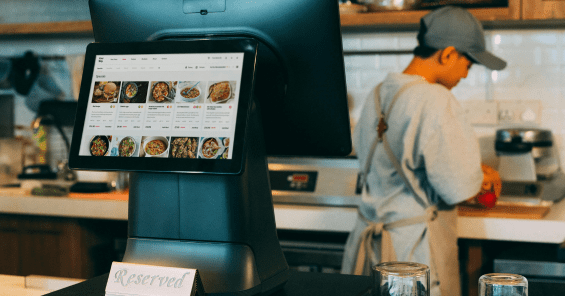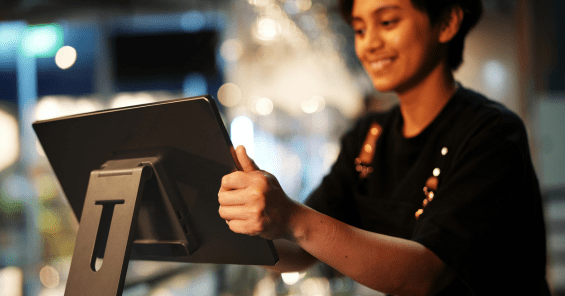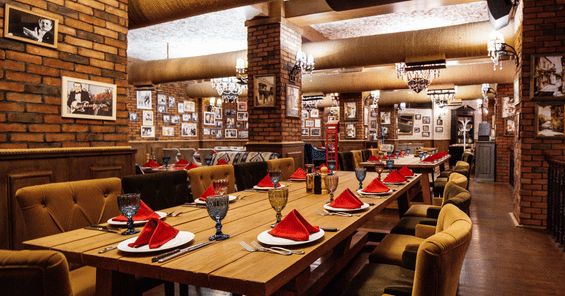

Restaurant Industry Changes to Expect in 2022
In this article, we asked several food entrepreneurs, chefs, and consultants on what changes they believe the restaurant industry will face in 2022.
The pandemic took the restaurant industry for a tailspin in 2020, changing business landscapes and altering social norms in its wake. Increasing convenience, safety, and digital transformation were at the forefront of the transitions we saw in the past two years. Simple notions like improving mobile ordering, boosting customer loyalty, and finding ways to ease drive-thru capacity were top of mind. Many restaurants needed to make unusual decisions, like—did their customers even need to dine in a physical space? With the new year around the corner, we can expect more changes in 2022. The most noteworthy restaurant trends show that restaurateurs are discovering innovative methods to improve on-site and off-site customer experiences, whether they're running a fast-casual cafe, a full-service business, or exploring a totally new concept altogether.
Six Laws of a Resilient Restaurant
Learn how to optimize every facet of your business, from menu optimization to tech solutions and gain actionable insights on saving money, driving engagement, and ensuring safety in your restaurant
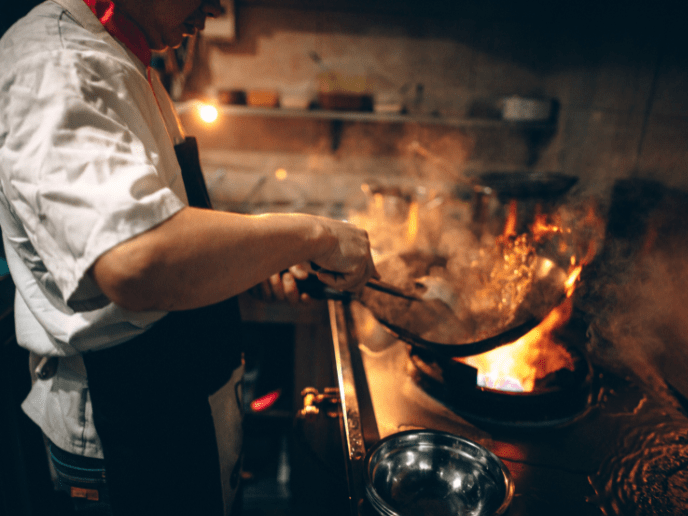
To uncover the strategies that will mold the restaurant industry in 2022, MarketMan interviewed some of the leading chefs, food entrepreneurs, influencers, and consultants to investigate what's coming up in the future. Let's check out some of the most popular restaurant trends for local food businesses to explore this upcoming year.
Advancements in technology from the pandemic
Utilizing technology and being forward-thinking about digital marketing and advertising strategies will be some of the main factors that will make-or-break restaurants in the new year.
Automation is a key tech advancement that will continue to shake up the industry, predicts Shawn Lalehzarian, owner of The Red Chickz Restaurant. "A big change that I can see happening in the industry would be automated service for placing orders inside of the restaurant instead of having a staff of cashiers or servers. Technology is going to come in and probably take some of those jobs, not only to simplify the operation, but also help with costs, and the challenges of staffing, and everything else that we have been facing the last 18 months."
Mark Kelnhofer, President & CEO of Return On Ingredients, agrees. "I see kiosks becoming big, where people just come up and they put their order in, settle their check, and submit the order." MarketMan partners with various brands of kiosks while seamlessly integrating with your inventory, POS system, and other software solutions you use to run your restaurant daily.
Being tech-savvy about marketing strategies will also be widely more adopted in 2022. "In the pandemic, there has been such an advancement in technology to support our marketing outreach, whether it be cost analysis, POS integration, or inventory management," says Matt Rolfe, Author of "You Can't Do It Alone."
David "Rev" Ciancio, a hospitality marketing consultant, also stressed that restaurants owning their social presence should be top of mind. One way to make sure you're doing a great job on social, says Ciancio, is to communicate with your guests at every step of their journey and truly own all your branded moments.
"You need to take the same service and hospitality that you extend on-premise and bring it online," says Ciancio. "You have to own the experience on Google, Yelp, Instagram, and over email. You have to be following up after the meal with communication to say, how was it? And when somebody leaves you a review on Yelp or Google, you have to reply to them as though they were on-premise."
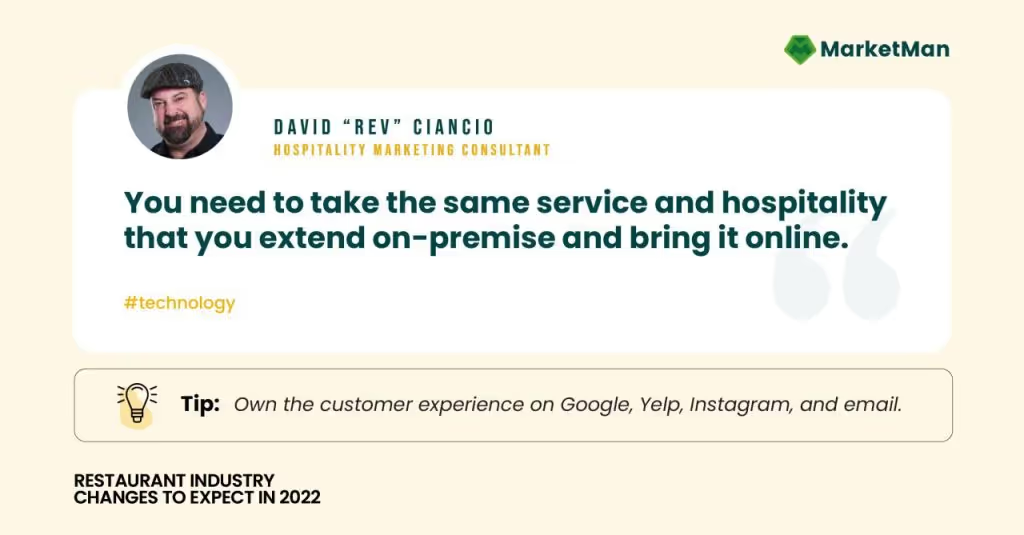
Changes in leadership and staff retention
It's no secret that the pandemic led restaurant workers to quit their jobs in record numbers. The U.S. Bureau of Labor Statistics recently reported that nearly 7% of workers in the foodservice industry quit their job in August, outpacing the 2.9% rate for the remainder of the economy.
The labor shortage has had restaurant operators worried for the duration of the pandemic, but Kelnhofer thinks there's a deeper issue. "It's not just about the extended unemployment. A lot of people left the hospitality industry during the pandemic and went to other industries, and they're simply not coming back to the industry." Kelnhofer has reason to believe this is why restaurants can't get consistent staffing in place.
Rolfe suggests completely overhauling your restaurant's communication rhythm for those looking to retain quality staff members. He recommends leadership and team meetings held once per week and doing regular space walk-throughs. Rolfe suggests shouting out your team—"Go up to your team members and recognize them for something positive because people aren't being seen right now. It is one of the most impactful, lowest cost things we can do to change our culture and also make us feel better in our days. Because we're all going through it right now."
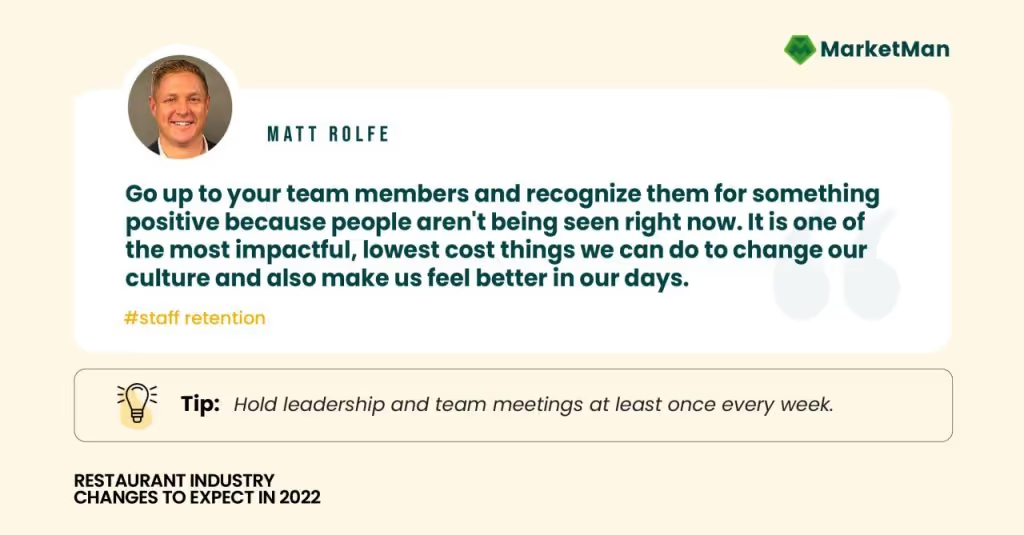
Restaurants will embrace takeout and delivery even more
One of the most undeniable shifts in the restaurant industry during the pandemic was the uptick of takeout and delivery services. "I think it's a fact to say the landscape has permanently changed,” says Andrew Martino, Founder/CEO for Ghost Truck Kitchen. "I think there's still going to be a big segment of people who are, of course, going to dine out and want to enjoy themselves and be amongst friends. But I think the digital adoption happened and behaviors changed, and people that never ordered delivery or takeout food became comfortable doing it."

Ciancio agrees and has suggestions for restaurants looking to up their takeout and delivery game. "The key is to build a system that mimics what the third-party delivery apps do to get customers to order from you directly instead."
What it comes down to, Ciancio believes, is customer communication. "If somebody orders from your restaurant using DoorDash, put a sticker on the takeout bag that says 'order from us directly.' That's one way to do it. The key is to make an effort to get them to come to your system and get guests not to go back to the third-party apps. That's where customer communication comes in."
New restaurant concepts will emerge
With a new year comes new possibilities for creative, innovative restaurant concepts. The pandemic greatly affected the physical setups of restaurants, and Lalehzarian believes that more industry leaders will add drive-thrus to their locations. "We'll see the giants that used to have one or two lines of drive-thrus, now open restaurants with four or five drive-thru lines," he predicts.
Mark Canlis, co-owner of Canlis in Seattle, learned a lot about this concept during the pandemic when he quickly shifted his fine-dining restaurant to a drive-thru burger business. "While the pandemic was a really bad time for a fine dining restaurant, it was a good time for drive-thrus. People can stay in their cars, they can just drive on through the restaurant, and we'll just come out and greet them with a burger."

The new concepts don't stop there—offering retail has also been a new trend. Bret Thorn, Senior Food and Beverage Editor for Nation's Restaurant News, gives the example of Momofuku. In 2019, the restaurant group planned to have consumer packaged goods, like their seasoned salts and chili crunch. They were going to roll out the products eventually, but they instead released them in 2020 because they needed to find different ways of making money. "That concept had always been in the works, and it should be in the works for every restaurant," Thorn says. "All restaurants should figure out what kind of retail they can do."
Consumers' new food choices will shift
Customers' dietary preferences have shifted drastically over the years, continuing to evolve into 2022. Cary Mosier, the owner of Cafe Gratitude and Gracias Madre, brings up the example of New York fine dining establishment 11 Madison Park, which is opening with an entirely vegan menu. "I think people are going to eat less and less meat, and we're going to continue to champion and support restaurants that are sustainable," Mosier says.
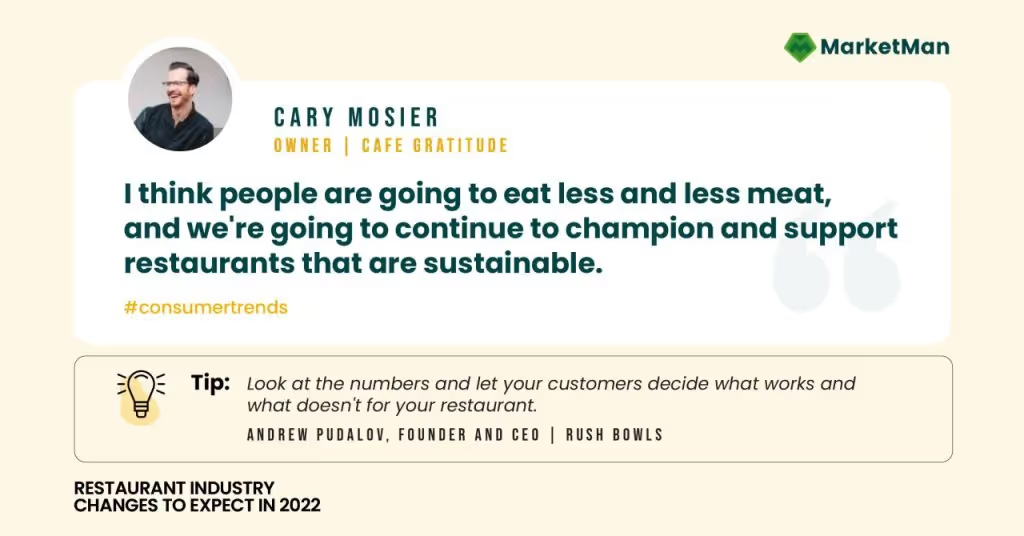
Andrew Pudalov, the founder and CEO of Rush Bowls, has advice for restauranteurs looking to be more agile, flexible, and adaptable with their menu options. A lot of our bowls were created by employees," Pudalov says. "We have a particular bowl that I tasted it, and I'm like, 'Yuck, this thing is disgusting.' I'm numbers-oriented, and it sold well, and it's like, bam, it's on the menu. Because ultimately I always had the perspective that it's the customer's point of view." He suggests looking at the numbers and letting your customers decide what works and what doesn't for your restaurant.
With these changes on the horizon in the restaurant industry in 2022, restaurateurs should remember to adopt new technology, communicate with customers, embrace new delivery and retail concepts, and more. Keep all of these trends in mind as you head into the new year, and good luck!

MarketMan's restaurant inventory management software is designed to automate inventory control, reduce food costs, and optimize all back-of-house activities. By eliminating manual processes, MarketMan empowers restaurateurs to work smarter, reduce waste, and gain insights for improved profitability. Take the guesswork out of restaurant management—book a demo today to experience how MarketMan can elevate your operations!
Author
Contributors
If you have any questions or need help, feel free to reach out
Don't miss out on maximizing your restaurant's profits! Calculate your ROI with MarketMan
Join over 18,000 restaurants and get the hottest restaurant tips delivered to your inbox
You may also be interested in
Ready to get started?
Talk to a restaurant expert today and learn how MarketMan can help your business



